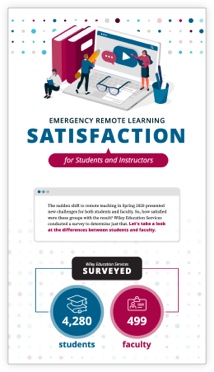Like many Americans, students spend nearly every waking moment looking at screens. They shop, order food, and connect with friends online, and this always-on lifestyle makes them quite digital-savvy. It also makes them more mindful about putting their data at risk.
Data mindfulness is important because search engines and other tech companies keep track of everyone’s online activity. But learners don’t just worry about Silicon Valley’s data collection methods. They wonder how every organization with an online presence will use their data. That includes your university.
But there are unobtrusive ways for your university to gather and use student data. What’s more, you can personalize the student experience to become a trusted guide throughout their learning journey.
4 Benefits of Personalization
Responsible data collection is essential because it makes personalization possible. It lets you understand who students are and tailor your content to them. Most learners don’t realize this personalization is occurring. Even so, you can boost their satisfaction by delivering information that meets their needs. This gives you the power to:
1. Give Students What They Want
Students are busy and want answers quickly. If they spend too much time searching your website for info, they may grow frustrated and turn to a competitor. But through personalization, you can keep students engaged by bringing relevant details to the foreground.
2. Make the Enrollment Journey Easier for Learners and Your University
Personalization transforms your website into a guide that shows each student what to do next. It also lets you remove webpage elements that a student already completed. Therefore, learners continue focusing on what matters now—and move one step closer toward enrolling.
3. Personalize Suggestions
Data reveals what prospective students want to learn and achieve. Once you accumulate this data, you can suggest programs that match their interests. By offering accurate suggestions, you will help students discover the best learning opportunities for their goals.
4. Help Students Feel Connected
Students want to know you’re there for them. Make connections with learners by showing the human side of your university. You can do this by including photos of your faculty and advisors in email messages or celebrating milestones like a student’s birthday. It’s these small actions that make your university memorable.
For examples of how to personalize your university’s content, check out our content personalization article.
Enjoying this article? Fill out our quick two-step form to stay up-to-date with our latest reports and infographics.

Using Student Data Responsibly and Legally
Web personalization helps universities stand out in ways that print media and TV/radio do not offer. That said, it’s up to each university to use student data responsibly. Not only do students deserve to know how universities will use their data, but recent data privacy laws give students the right to learn this information.
In the U.S., the California Consumer Privacy Act (CCPA) gives consumers the right to know if businesses are compiling information about them. They can also tell businesses to delete their data and never sell it.
Other states will likely follow California’s lead to pass strict data privacy laws. That’s because regulators understand data is a valuable currency. As such, they want to require organizations to practice strong ethics when using personal information.
These laws add to existing regulations that universities follow, such as Family Education Rights and Privacy Act (FERPA) requirements for protecting student data. While it’s now standard to follow FERPA rules to safeguard each student’s address, bank account information, and social security number, privacy rules for online activity are changing rapidly. As a result, it’s vital for universities to understand how these changes impact their digital marketing efforts.
Of course, safeguarding user data is just one challenge universities face when personalizing websites. They also must recognize when personalization goes too far.
Make Content Personal—But Not Too Personal
Personalized content indeed boosts your chances of driving more conversions. But if you over-personalize the web experience, students may find it intrusive.
A big personalization no-no is adding a student’s first name to web content. Even if a student provided this information through an RFI form, it should not be used. Sure, including a student’s name in a web headline may seem like a shortcut to connecting with them. But it will more than likely have the opposite effect, as the student may fear the university has pried into their privacy.
Pop-ups that comment on a student’s behavior are another example of over-personalization. For instance, if a student visits a university’s financial aid webpage, a message may appear that says, “I see you’re looking for student loan details. Can we chat?” While these pop-ups may seem attentive, they often cause a Big Brother effect. And if the student feels like they’re being watched, they may flee.
But there are tactics that engage students without making them uneasy. One solution is not to limit personalization to your website. Instead, let a student’s web activity trigger emails and other personal communications.
For instance, imagine a student is lingering on your financial aid, FAFSA, and tuition pages. Your system could trigger an email that details the steps for paying for tuition. These messages give you chances to assuage cost concerns by including student testimonials about the value your degrees provide.
This communication won’t seem aggressive if you don’t reveal that you sent it because of the student’s activity. They may think the email is a standard message sent to all students. At the same time, it provides details they were seeking and helps them take the next step toward applying.
A lot goes into achieving this level of personalization. Fortunately, universities can harness a variety of tools to tailor content and protect data privacy.
Tools That Bring Data Privacy and Personalization Together
There’s a simple way to respect student privacy: Only gather the data you need to personalize and streamline their experience.
Customer data platforms (CDPs), like Tealium AudienceStream, make it easier to manage this process. At Wiley University Services, we harness a CDP to manage the personal details that we compile, using a combination of cookie IDs, first-party data, and web signals to focus on each student’s actions and traits. By gathering this behavior data, we can assign the learner to a persona.
Personas let us segment students based on the actions they take, like the types of webpages they visit or the content that piques their interest. But we don’t tie their personal information to those actions. The CDP records identifiable information only when a student chooses to provide it through a contact form.
After assigning a student to a persona, we utilize Optimizely to customize their experience based on the persona. Think of this platform as an assistant that matches students with the best web experience for their traits. It also enables us to test which messages, images, and promotional offers work best with each persona.
Here’s how these platforms work together: Picture a young professional who works in advertising. She has a bachelor’s degree in marketing and wants to continue her education to access new career opportunities. So, she begins looking for online graduate programs relevant to her field.
When she visits a university’s website, she checks out the MBA and graduate-level data analytics programs. On each page, she stops scrolling to read about career outcomes and how soon she can earn each degree. The CDP creates her profile, pays attention as she looks at content, and assigns her to a persona. After that, we modify the webpages to display images and content based on her assigned persona.
From there, her experience can be refined to present the content that appeals to her most. These efforts increase the chances that she will find exactly what she needs and then request information. And, most importantly, this is all done without prying into her data.
Personalize Your Content for Impact
Many prospective students think their data is none of your business, making it necessary to safeguard their privacy. At Wiley University Services, personalizing content in ways that respect data privacy is a part of our business.
Discover how we can enable your university to meet ever-changing data privacy standards. We deliver innovative solutions for personalizing your marketing content, increasing enrollments, and supporting the entire learner journey.

















